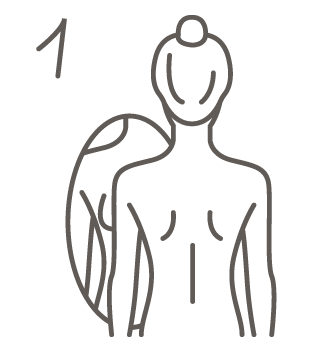MY BREAST HEALTH.
Learn more about breast pain, self-exams, and other breast health-related issues.
BREAST PAIN. SHOULD I BE WORRIED
If you have breast pain, you are not alone. Breast pain, also known as mastalgia, is common and accounts for 45-70% of breast-related health care visits. The good news is that most causes of breast pain are benign (non-cancerous) and usually related to hormonal changes in your body or something as simple as a poor fitting bra. Breast pain varies a lot from person to person and may feel like a dull ache, tenderness, burning sensation, sharp pain, or just a sense of uncomfortable fullness. To understand what causes breast pain and what to do about it, it is important to understand a little bit about the different types of breast pain.
Types of breast pain
There are two main types of breast pain. The first type is cyclical and changes with hormonal changes in your body. Cyclical breast pain typically involves both breasts, involves either the entire breast or the upper outer portion, and may radiate to the armpit. Most importantly, it varies with your menstrual cycle. Cyclical breast pain is usually worse during the week before you start your period. The pain usually subsides or improves after your period. With cyclic breast pain, it is also common to feel like your breasts are lumpier during the week before your period. Cyclical breast pain is the most common type of breast pain and usually does not require any treatment or medical evaluation.
The second main type of breast pain is noncyclic breast pain. Noncyclic breast pain usually involves only one breast and is not related to your menstrual cycle. It can be constant or intermittent, just not associated with any particular pattern. The cause of noncyclical breast pain is often harder to determine. Just like with cyclical breast pain, most causes of noncyclical breast pain are benign. The most common cause is a poor-fitting bra. Other causes include pregnancy, trauma, muscle strain, and prior surgery.
Although breast cancer is usually not painful, when it does cause pain, the pain tends to be noncyclical and usually just in one focal spot. Because of this, noncyclical breast pain may require a little more evaluation to determine the cause.
DENSE BREASTS
The purpose of screening is to enable the early detection of breast cancer, so we can find it when it’s small and most easily treatable. Early detection begins with mammography—the only screening tool proven to reduce breast cancer deaths.
What is breast density?
Breast density is a description of how your breast appears on a mammogram. It is determined by the radiologist, the doctor reading the mammogram.
Breasts are made up of fibrous and glandular tissue and fatty tissue. On the mammogram, fibrous and glandular tissue appears white and fatty tissue appears black. A dense breast contains mostly white fibrous and glandular tissue.
There are four categories of breast density on a mammogram: almost entirely fatty, scattered areas of fibroglandular density, heterogeneously dense, and extremely dense. Women with mammograms that are heterogeneously dense or extremely dense are considered to have "dense breasts”.
Breast density may decrease with age, but for most women, there is little change.
Dense breasts are normal and common. About half of all women have dense breasts.








